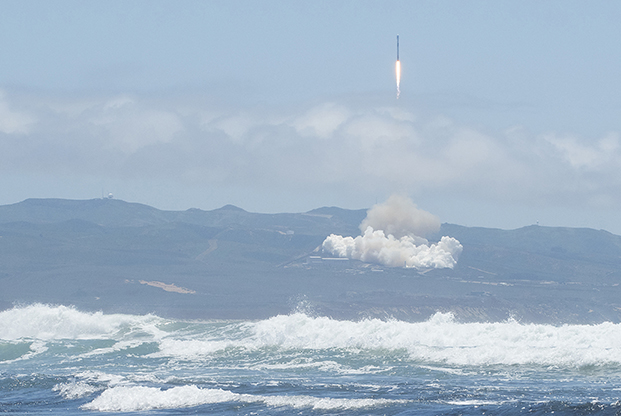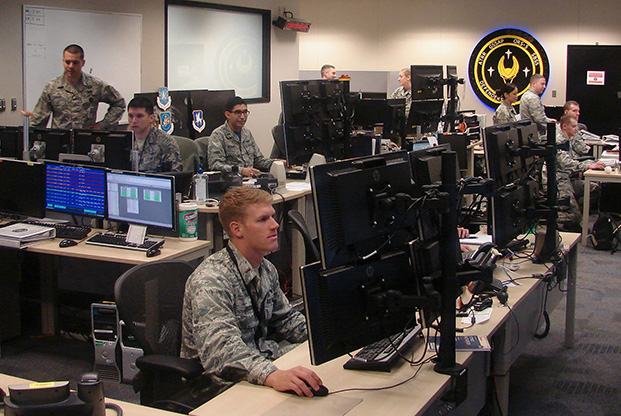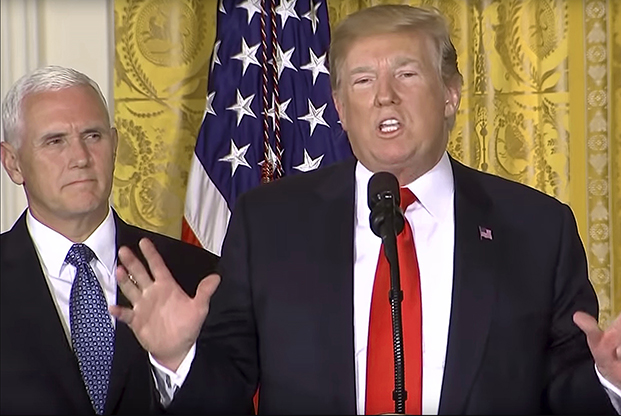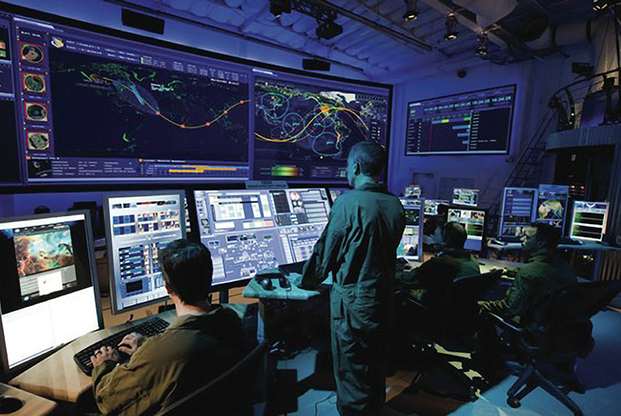
A Space X Falcon 9 rocket hefts Iridium and Grace-FO (Gravity Recovery and Climate Experiment Follow-On) payloads from Space Launch Complex-4 at Vandenberg AFB, Calif., in May. Photo: SrA. Clayton Wear
Air Force officials at the National Space Symposium in April touted a substantial block of initiatives they are taking to toughen the US approach to military space. However, members of Congress remain unconvinced the Air Force alone should continue to manage the lion’s share of the nation’s military space enterprise without more radical changes.
USAF speakers emphasized that it’s the mission, and not necessarily organizational boxes, that define the military space issue.
Gen. John W. Raymond, head of Air Force Space Command and US Strategic Command’s Joint Force Space Component, said the nation has come to a “strategic inflection point” for national security space. It warrants a “bold shift toward warfighting space superiority,” he told reporters, adding that steps taken by the Air Force to bolster military space capabilities are meant to further national goals, not just those of the service.
“Space superiority” is a joint requirement that Raymond argued is fulfilled by the Air Force, which regards it as a core mission. It’s “not just a space officer’s task; it’s a joint warfighter’s task.”
Gen. John E. Hyten, commander of STRATCOM, struck a similar note, telling reporters that while organizing for space is getting the most attention from government, “the key—in my perspective—is the organization is secondary. The need to deal with the threat is primary.”
Raymond said in 2017, when he was new to the job, there were few new accomplishments to report from Space Command, and so in last year’s speech he talked about service anniversaries and a “Space Warfighting Construct,” or a concept for the future.
This year, he said that construct “does not exist anymore. It is a reality.” What it all “boils down to is warfighting.”
Last year Raymond was named to be dual-hatted as head of STRATCOM’s joint force space component. As the command was restructured, he consolidated 18 disparate component commands into four components for air, space, sea, and missile defense. The change, AFSPC spokesman Lt. Col. David Westover said at the time, would “improve our nation’s space warfighting effectiveness.”
Raymond said the post’s “elevation from a three-star to a four-star operational component has been significant.” It amounted to more than simply “adding a letter to the name of an organization,” but provided a way to integrate within STRATCOM. Perhaps more importantly, he said the move created a way to integrate STRATCOM with other geographic combatant commands worldwide.
In January, the National Space Defense Center went to a 24/7 operating tempo. Relying on Pentagon and Intelligence Community support, it detects and defends against threats to space systems. This shift, Raymond said at the time, “immediately expands our space situational awareness and bolsters our readiness,” both critical to space superiority.
In addition, the Joint Space Operations Center at Vandenberg AFB, Calif., will later this year become the Combined Space Operations Center, with increased international participation. The current joint center—known in the Pentagon as “JSpOC” for short—already includes exchange officers from Australia, Canada, and the UK.
Maj. Gen. Stephen N. Whiting, commander of AFSPC’s 14th Air Force and Raymond’s deputy at STRATCOM, told the symposium the transformation of the JSpOC into a CSpOC will “improve how we operate with those closest allies and their indigenous country space operations centers,” improving space situational awareness and combined operations “for all involved.”
The combined center will create and unify capabilities “that fill gaps so that we can operate this as a better enterprise,” he said.
There would be benefit to increasing personnel exchanges between the various allied space AOCs, Whiting said. Eventually, as the center becomes evermore capable, AFSPC desires to “move beyond those traditional partners because there are so many other partners here in the room … who we are working with day-to-day, … and we want to bring them into the CSpOC as we move forward.”
Besides the operations center, Raymond said another initiative to bring allies more closely into the space enterprise includes inviting them to participate in the annual Schriever Wargames. Besides the so-called “Five Eyes” of the intelligence alliance— the US, Australia, Britain, Canada, and New Zealand—the guest list has been expanded in recent years to include France and Germany. This year, Japan is participating.
USAF is also increasing space’s role in realistic combat training exercises. The Air Force inaugurated a new “Space Flag” wargame in 2017, and Raymond said its frequency will be increased from two to three times annually.
In terms of leadership, USAF is “reviewing our space professional development and the space force structure needed” to develop a sustainable leadership track.

Space surveillance crews operate satellite vehicles in the new combined ops floor at Schriever AFB, Colo., in 2017. Photo: SrA. Arielle Vasquez
Air Force Secretary Heather Wilson announced three further initiatives to expand foreign participation in USAF space training. Two new courses are to be added to the National Security Space Institute at Peterson AFB, Colo., including one on space situational awareness, for partners and allies to learn more about collision avoidance, deorbits, and reentry. In addition, she said, more of the existing advanced courses on national security space are to be open to members of allied militaries. The courses were already open to Australia, Canada, and the United Kingdom; invitations will be extended to New Zealand, France, Germany, Japan, and possibly others.
“Why now?” Wilson asked. “Because we face a more competitive and dangerous international security environment than we have seen in decades. Russia and China are developing capabilities to disable our satellites. We will work with like-minded nations to preserve the ability to freely and safely operate in space. We will work with our allies to enhance deterrence, defend our vital national interests, and prevail if called upon to do so,” she said.
The SECAF also announced the creation of a new office, reporting to Air Force acquisition chief Will Roper, to speed up space-related acquisition. The Space and Missile Systems Center, which handles Air Force space systems procurement, is also to be restructured to increase efficiency.
“You can call it SMC 2.0,” Wilson told attendees at a symposium dinner.
The organizational redesign, she said, will collapse stovepipes and establish a “chief architect to consider the entire space enterprise.” In addition, SMC will have a production core, separate from its development core, and there will be sections focusing on innovation and one to drive partnerships.
“There is much work to be done, and we look forward to doing it together with all of you,” she told the audience. “No other organization in the world can do what we do, and we’re only getting faster and better and going farther.”

President Donald Trump, accompanied by Vice President Michael Pence, instructs the Department of Defense to begin establishment of a Space Force during a press conference on June 18. Photo: C-SPAN
SPACECOM AND SPACE CORPS
Despite consistent, detailed opposition to the idea from the Air Force leadership, congressional enthusiasm for a new space service seemed unabated in the following weeks. Passions about the subject flared at a House Armed Services Committee markup of its version—its “mark” in congressional vernacular—of defense authorization legislation.
The Strategic Forces Subcommittee leadership firmly supports the creation of a separate space force.
“Since last year, President Trump has endorsed the establishment of an independent space force,” subcommittee Chairman Mike Rogers (R-Ala.) said, adding that he and ranking subcommittee Democrat Jim Cooper (Tenn.) “remain committed to laying the foundations for that force within this committee.”
The full committee considered a proposal from the Strategic Forces Subcommittee to include language to bring back SPACECOM as a subordinate unified command under STRATCOM.
During the 14-hour markup session, the panel rejected an amendment proposed by Rep. Mike Turner (R-Ohio) to link creation of the command to an ongoing review of how the Pentagon structures its space enterprise.

The Joint Space Operations Center at Vandenberg AFB, Calif., detects, tracks, and identifies artificial objects in Earth orbit. Photo: USAF
Turner told the committee he was offering his amendment for purposes of “legislative consistency.” Though the review of space organization is ongoing, Turner said “we’re going to jump forward in this mark and direct DOD to undertake a reorganization while we’re asking them to study the reorganization.”
Regardless of what the report ends up saying, Rogers said, certain steps must be taken, including reestablishing SPACECOM as a subunified command.
Cooper was more pointed in his remarks.
“The Air Force has simply not prioritized space as it should have and this is a way to get it back on track so that we do not face the catastrophic risk that we face of being rendered deaf, dumb, and blind by a surprise attack in space before we even knew what was going on,” Cooper asserted. “So I would urge all members of the committee to oppose this amendment,” he said, accusing Turner of “trying to slow walk the work of the subcommittee.”
Also speaking against the amendment was Rep. John Garamendi (D-Calif.), who pointed to seven hearings that had been held in the subcommittee. He alleged that each of these hearings resulted “in the same very profound, important point and that is, ‘We are not prepared to defend this nation’s space assets in large part because we are not organized to do so.’?”
All the hearings concluded that the Unites States must organize its military “in a way to defend perhaps the most critical element in the Department of Defense, which are our space assets,” Garamendi asserted.
The Turner amendment was defeated by a voice vote, meaning as of early June the House had passed its version of the bill, including the space language; the Senate Armed Services Committe version of the bill had not yet come up for floor debate.